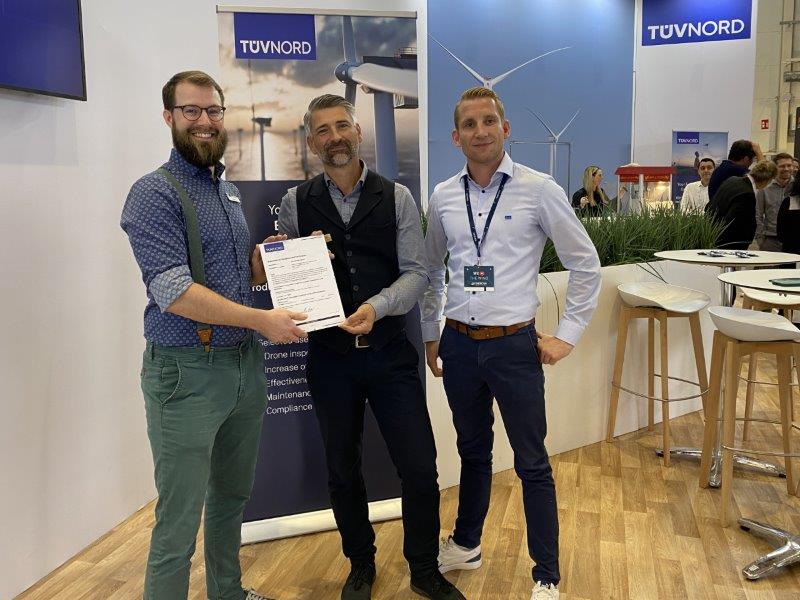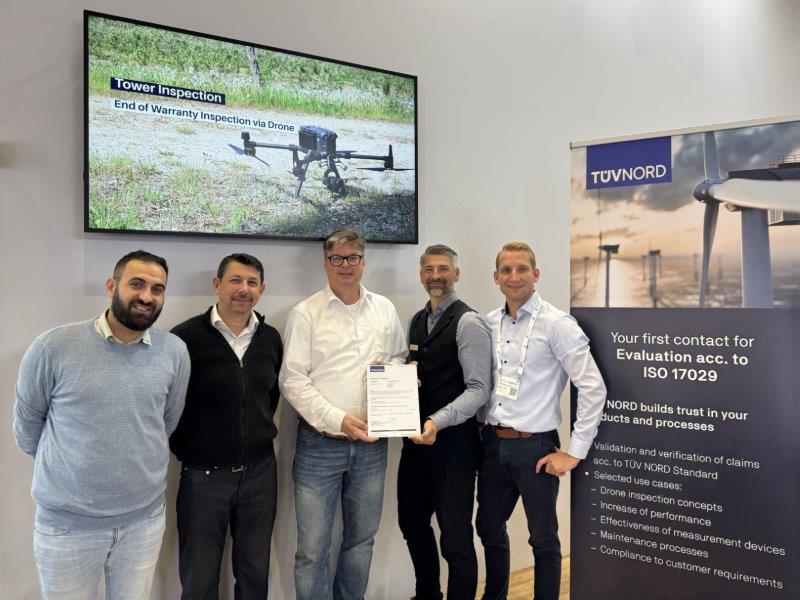More and more wind turbines are being inspected with the help of drones, particularly with regard to the lightning protection system and possible damage to the rotor blades. TÜV NORD is using a new in-house standard to check whether these drone-based methods deliver what they promise. The first verification has now been completed and the conformity assessment handed over to Deutsche Windtechnik.
This is the first time that TÜV NORD has completed the verification of a drone system for Deutsche Windtechnik. The conformity assessment of this successful verification was handed over at the WindEnergy trade fair in Hamburg on 26 September 2024. Deutsche Windtechnik's technology had already been validated in February. The validation for start-up OMI Innovation has also been completed; verification will follow shortly.
'To cut a long story short, our conformity assessment says whether a system or process works as promised by the manufacturer. We distinguish between validation and verification: validation involves assessing whether the intended use, the future use, is plausible. Verification, on the other hand, involves checking whether the assertions made by the manufacturer in retrospect were true and whether the desired results were achieved in practice,' explains Michael Lange, head of the validation and verification unit for wind energy at TÜV NORD.
In the specific project for Deutsche Windtechnik, TÜV NORD evaluated the procedures used to detect damage to the rotor blades or to the lightning protection system of the wind turbines. For this purpose, the independent inspection body of Deutsche Windtechnik prepares a risk analysis as part of the annual inspection, which determines what can be inspected using a drone and where rope access technology must also be used. The aim is to detect damage such as erosion or cracks that can occur, for example, due to wind and weather, bird strikes or lightning strikes. Every two years, or every four years if a maintenance contract is in place, an additional periodic inspection by an approved inspection body such as TÜV NORD is required; here, too, drones are now often used for an initial assessment of the turbine's condition.
The market for drone-based inspections is growing, and there are now numerous providers in the market – both established maintenance companies and many newly founded start-ups. ‘Drone inspections are becoming a central component of many inspection concepts,’ says wind energy expert Michael Lange.
Since there has been no standard to date that defines how inspection procedures using drones can be evaluated, TÜV NORD has developed an own in-house standard for this purpose. As a result, conformity assessments can now be issued for the first time, including both validations and verifications. TÜV NORD standard TN-P-V01-001 is based on the requirements of the ISO 17029 standard, which defines the work of verification and validation bodies. ‘On the basis of our standard, we can also check statements about digital optimisation tools, measuring systems or mechanical attachments for wind turbines to see if they are plausible and truthful,’ adds Michael Lange.
About TÜV NORD GROUP
Since our foundation more than 150 years ago, we have been the global byword for security and trust. As a knowledge-based company, we have the digital future firmly in mind. With specialists ranging from engineers and IT security professionals to professionals for the mobility of tomorrow, we use our expertise in over 100 countries to ensure that our customers will be even more successful in the networked world.

